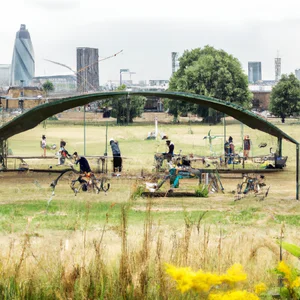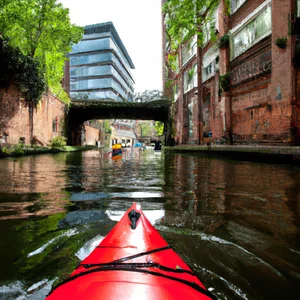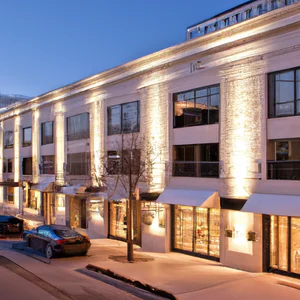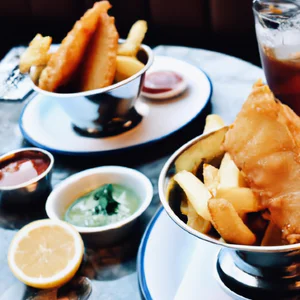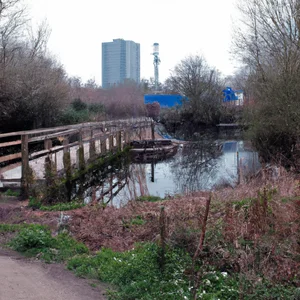Book your experience
Notting Hill: Bohemian shopping and charming boutiques in Portobello
Notting Hill, ah, what a place! It’s a bit like a daydream, with its mix of charm and a pinch of madness. If you think about it, it’s like walking in a movie: the colorful houses, the markets… and then Portobello!
So, let’s talk about shopping. It’s not the usual shopping in large shopping centers, no! Here you can breathe a different atmosphere. The boutiques are like small pearls, each with its own history. I remember once I went into a little shop, and there was an elderly lady selling vintage clothes. I felt like an explorer looking for treasure. Between a 70s dress and a bag that looked like it came out of an Audrey Hepburn film, I found a jacket that I now wear whenever I want to feel a little special.
And then, the Portobello market is a real spectacle! There are stalls selling everything: food, household items, strange objects you never thought you’d want to buy. Sometimes I ask myself: “But who really buys these things?”. But, you know, there is always that charm in the unexpected, in finding something unique. Maybe that’s why people come from everywhere.
Furthermore, to tell the truth, the place is a bit touristy, of course, but it has a soul that conquers you. And even though there are a lot of people, I think that’s what makes the atmosphere so lively. I don’t know about you, but I like to mix with the crowd, observe, listen to the stories that everyone brings with them. After all, every corner of Notting Hill has something to tell, like an old friend you haven’t seen for a while.
In short, if you feel like taking a tour, I recommend getting lost among the colorful streets and maybe stopping for a coffee in one of those cafés that seem like something out of a novel. You won’t be disappointed, I guarantee it!
Portobello Road: the beating heart of the market
A personal experience in the vibrant market
I remember the first time I set foot on Portobello Road; the air was filled with palpable excitement. It was a Saturday morning and the street, lined with colorful houses, was alive with vendors displaying their products. While walking, I was struck by a small stall where an elderly craftsman was selling handmade ceramic works. In that moment, I understood that Portobello is not just a market, but an immersive experience that reflects the culture and soul of Notting Hill.
Practical information on the market
Portobello Road Market is open every day, but the best time to visit is on Saturdays, when the market is booming and over 1,000 vendors can be found. The stalls stretch for nearly a mile, offering everything from antiques to fresh produce. For further details, you can consult the official website of the Portobello market, where opening times and special events are updated.
An insider tip
If you want a more authentic experience, I recommend arriving early, before the crowds make themselves felt. Discovering the antique stalls when they open will allow you to talk to the sellers and learn the story behind each unique piece. Don’t forget to ask about the most interesting items; many sellers love to share their stories!
The cultural impact of Portobello
Portobello Road has a rich history dating back to the 19th century, when the market was mainly dedicated to selling fruit and vegetables. Today, it has become a symbol of London’s cultural diversity, representing a fusion of traditions, styles and influences. It is a place where different cultures, languages and histories meet, making it a point of reference not only for shopping, but also for the melting pot of experiences it offers.
Sustainable tourism practices
In an era where sustainability is fundamental, Portobello has become an example of responsible tourism. Many sellers are committed to using recycled materials and supporting ethical manufacturing practices. Choosing to buy from local artisans not only helps the neighborhood’s economy, but also helps preserve the authenticity and character of the market.
Vibrant and engaging atmosphere
Walking along Portobello Road is a sensory experience. The bright colors of the stalls, the scent of street food and the sound of laughter and conversation create a contagious energy. Every corner tells a story, every object has a soul. It is not uncommon to find street artists entertaining passers-by with music and performances, making the market a living stage.
An activity worth trying
As you explore the market, don’t miss the opportunity to stop by one of the many street food stalls. Try an authentic Jamaican jerk chicken or a delicious French crepe. These dishes will not only satisfy your taste buds but also take you on a culinary journey through different cultures of the world.
Myths to dispel
A common misconception is that Portobello Road is just a market for tourists, but in reality, it is also frequented by local residents looking for fresh produce and quality items. This mix of visitors and inhabitants makes the atmosphere even more welcoming and authentic.
Final reflection
As you immerse yourself in the exciting world of Portobello Road, ask yourself: “What really makes a market a special place?” Is it just trade, or is it something deeper, like the connection between people and their culture? Portobello is not just a place to shop; it is a haven of stories, traditions and human connections. Let yourself be inspired by the magic of this market and discover what it can offer you.
Hidden boutiques: treasures to discover
Walking along the lively streets of Notting Hill, I remember the moment I discovered a small boutique hidden behind a dark wooden door. The entrance was almost invisible, adorned with a gracefully climbing ivy plant. Once inside, the scent of handcrafted candles and fine fabrics enveloped me, like a warm hug on a rainy day. This boutique, called The Hidden Gem, is a perfect example of how the neighborhood hides real treasures.
A unique shopping experience
Notting Hill boutiques are more than just shops; they are spaces cared for with passion, where the owners are often also the designers. Many of them offer unique, handmade garments that tell stories of creativity and innovation. Local sources, such as the Notting Hill Guide, report that these small businesses contribute significantly to the neighborhood’s economy, attracting visitors in search of authenticity.
An insider tip
If you want to discover lesser-known boutiques, try visiting during the Notting Hill Carnival in August. Even though the market is crowded, many local designers display their creations in temporary spaces, offering unique pieces that you wouldn’t find in traditional shops. Plus, owners are often happy to share stories about their work, making the shopping experience even more personal.
The cultural impact of boutiques
Notting Hill’s boutiques are not just places to shop, but also centers of culture and community. These shops reflect the diversity and history of the neighborhood, once known for its colorful homes and lively market. Today, boutiques continue to keep the heritage of this place alive, offering products that celebrate the cultural and artistic roots of the area.
Sustainability in shopping
In an age where sustainability is in focus, many Notting Hill boutiques are adopting eco-friendly practices. From choosing organic materials to ethical production, retailers are increasingly aware of the environmental impact of their activities. Buying in these boutiques means not only finding unique items, but also supporting a responsible local economy.
An activity worth trying
For a truly memorable experience, book a guided tour of Notting Hill’s boutiques. These tours will not only take you to hidden places, but will also offer you the chance to meet the designers and discover the creative process behind their works. It’s an opportunity to buy direct from the producers and bring a piece of Notting Hill home.
Myths and misconceptions
A common misconception is that shopping in Notting Hill is only for those on a high budget. In fact, there are many boutiques that offer affordable options, allowing anyone to discover the beauty and uniqueness of the neighborhood. Don’t be put off by clichés: authenticity and quality can often be found at reasonable prices.
A personal reflection
After exploring the boutiques of Notting Hill, I found myself reflecting on how shopping can be a connecting experience with the local community. What stories do the objects we choose to bring home contain? The next time you enter a boutique, ask yourself not only what you are buying, but also from whom and why. This simple gesture can transform a purchase into a meaningful meeting.
Vintage shopping: a journey through time
A memory of another time
I fondly remember my first encounter with the world of vintage shopping in Notting Hill. It was a sunny Saturday morning, and as I strolled along Portobello Road, I was drawn to a small boutique with a window filled with vintage clothing and accessories. Upon entering, I was greeted by an elderly lady with a warm smile, who told me the story of each piece on display. From that moment, my love for vintage began, a journey that led me to discover not only unique styles, but also fascinating stories.
Where to find the best vintage treasures
Notting Hill is famous for its market, but off the main streets, there are hidden boutiques where true vintage shopping comes to life. Places like The Vintage Showroom or Ragged Priest offer a curated selection of one-of-a-kind pieces that tell stories of bygone eras. It’s best to visit Portobello Market on a Friday or Saturday, when local vendors display a variety of vintage items, from 1960s clothing to handcrafted jewelry.
An insider tip
If you want an even more authentic experience, try visiting lesser-known markets, such as West 12 Shopping Centre, where some local vintage shops offer special discounts. Here, you can often find unmissable deals, far from the crowds of tourists that crowd the most famous streets.
The cultural impact of vintage shopping
Buying vintage clothing isn’t just a matter of style; it’s a way to embrace sustainability and reduce the environmental impact of fashion. Notting Hill’s vintage culture represents a return to more authentic values, where originality and quality prevail over mass production. This approach not only celebrates the history of fashion, but also encourages more conscious consumption.
An experience not to be missed
For a truly unique experience, attend a vintage restoration workshop at one of the local shops. Here, you can learn how to repair and personalize your garments, transforming a simple purchase into a personal and sustainable work of art.
Dispelling the myths
A common misconception is that vintage shopping is only for those looking for eccentric clothing. In fact, there is a wide range of styles, from timeless classics to bolder, more modern pieces. Anyone can find something that suits their personal taste and wardrobe.
Final reflection
As you explore the world of vintage shopping, ask yourself: what stories could the clothes we wear tell? Each item is a piece of history, a link to the past that is worth discovering and appreciating. Start your journey through time in Notting Hill and be amazed by the beauty and uniqueness of vintage.
Street food: authentic flavors to try
A sensorial journey among the market stalls
Every time I find myself on Portobello Road, an enveloping scent of spices and freshly cooked food captures me, taking me back to a warm summer day spent exploring the wonders of Notting Hill. I remember enjoying a spicy jerk chicken from a local kiosk, the succulent, smoky meat melting in my mouth, accompanied by a portion of rice and peas. That simple gastronomic experience has become a lasting memory, a taste of this neighborhood’s vibrant culture.
Portobello Market: a culinary treasure
Portobello Market, open every day but particularly lively on Saturdays, is the ideal place to discover authentic street food. The stalls offer a variety of dishes that reflect the multiculturalism of London. From crispy falafel to French crepes to traditional Jamaican desserts, every bite tells a story. The different origins of the vendors and their dishes make this market not just a place to eat, but a real journey through the cultures of the world.
An insider tip
For a truly authentic experience, seek out Mama’s Jerk, known for its jerk chicken marinated in a secret family recipe. Don’t be fooled by the line you might find: it’s a sign that you’ve found a real treasure. Also, ask to try the homemade hot sauce; it’s an explosion of flavor you won’t easily forget.
Food and culture: an indissoluble bond
Street food has had a significant impact on the culture of Notting Hill, transforming the market into a meeting point for different communities. This is not just a place to buy food, but also a space for cultural exchange, where culinary traditions blend and reinvent themselves. Portobello Road’s recent history is intrinsically linked to its evolution as a food market, which has helped make it one of London’s best-loved destinations.
Sustainability and responsibility
In a time when sustainable tourism is more important than ever, many vendors at Portobello Market are making an effort to use local ingredients and eco-friendly practices. By choosing to eat from these kiosks, you not only enjoy exceptional dishes, but you also support small businesses that respect the environment.
A tasty proposal
A must-do activity is to take a guided food tour of Notting Hill, where you can sample the best street food dishes and hear fascinating stories about the vendors and their recipes. These tours will not only allow you to try a variety of flavors, but also discover hidden corners of this charming neighborhood.
Myths and misconceptions
A common misconception is that street food is unhygienic or of poor quality. In fact, many vendors are passionate chefs who use fresh, high-quality ingredients, often sourced from local producers. Remember, street food on Portobello Road is a dining experience worth having.
Final reflections
Every bite of street food on Portobello Road is like a little journey through time and space, inviting you to reflect on the richness of the culinary traditions that surround us. Which dish intrigues you the most and which story do you think you can discover by tasting it?
Street Art: Exploring the Creative Side
Walking along the lively streets of Notting Hill, I came across a mural that perfectly captured the essence of this neighbourhood: bold colours, abstract shapes and a message of hope. It was a sunny morning and the street art seemed to be dancing at the rhythm of life that pulsated around me. This is not just superficial decoration; it is an expression of the heart and soul of a community that has made creativity its language.
Street art as a voice of the community
Notting Hill is a stage for some of London’s best street artists, with works ranging from giant murals to small stencil works hiding between the walls. Artists like Banksy and Stik have left their mark here, but the real charm lies in the heterogeneity of artistic expressions that can be found. Every corner tells a story, often linked to social and cultural themes that reflect the daily life of the community.
For those who want to delve deeper, I highly recommend visiting the Notting Hill Carnival, which takes place every year at the end of August. During this event, street art explodes in a colorful celebration of culture and music, with artists creating live works and performances that engage the public.
An insider advises
Here’s a little-known tip: while walking, don’t forget to look up! Many street artists have created works on building facades and rooftops, so looking up can reveal real hidden treasures that you might otherwise miss.
A profound cultural impact
Street art in Notting Hill is not just an aesthetic issue; it is a powerful tool for social change. The artworks address issues such as gentrification, cultural identity and contemporary challenges, making art an integral part of the historical and social narrative of the neighborhood. This is particularly important in an area with a history of diversity and integration.
Sustainability and responsibility
With increasing environmental awareness, many street artists in Notting Hill are using sustainable materials and eco-friendly techniques for their works. Participating in responsible street art tours not only allows you to discover these talents, but also supports artistic practices that respect the environment.
Immersion in the atmosphere
Imagine walking along the streets, the air is filled with the scents of street food and music echoing in the distance. Every corner is a work of art in itself, and the atmosphere is vibrant and welcoming. You feel part of something bigger, a movement that celebrates creativity and individual expression.
Activities to try
For an unforgettable experience, join a street art tour led by local artists. These tours not only offer an overview of the most famous works, but also the stories and techniques behind them. An excellent way to understand the true soul of Notting Hill.
Myths to dispel
One of the most common myths is that street art is just vandalism. In reality, it is a legitimate art form that requires talent, commitment, and a deep connection to the community. Often, street art works are commissioned or created in collaboration with residents, strengthening the connection between the art and its context.
Final reflection
As you enjoy the beauty and creativity of Notting Hill, ask yourself: How can street art influence my perception of culture and community? Immersing yourself in this aspect of Notting Hill can open your mind and heart to new forms of expression and meaning.
History of Notting Hill: beyond the famous film
A blast from the past
When I first set foot in Notting Hill, the smell of fresh flowers and the sound of laughter coming from the crowded cafes immediately made me feel at home. I remember walking along the cobbled streets, admiring the pastel-colored houses, and being fascinated by the history that permeated every corner. My attention was caught by a small plaque on a wall, declaring that the first civil rights demonstrations took place on that same street decades ago. This made me reflect on how Notting Hill is not just a film set, but a place full of stories and meanings.
Practical Information
Notting Hill is famous for its Portobello Road market, but its history goes far beyond its cinematic image. Originally a rural area, it became a center of immigration and cultural change in the 1950s and 1960s. Today, the neighborhood is a vibrant fusion of cultures, with Caribbean influences reflected in local festivals, such as the famous Notting Hill Carnival. For an authentic experience, visit Portobello Market on a Saturday morning; it’s the best time to discover not only vintage items, but also the pulse of community life.
Insider tip
A little-known tip? Don’t limit yourself to the main market. If you move away from the busier streets, you will find small shops and art galleries that tell stories of local artists. A visit to Westbourne Grove will lead you to discover charming boutiques and cafes serving some of the best breakfasts in London.
Cultural and Historical Impact
The history of Notting Hill is intrinsically linked to the fight for civil rights and street art. In the 1970s, the neighborhood saw a radical transformation, becoming a symbol of diversity and welcome. The streets, once silent, are now a stage for cultural expression, where the past and present intertwine in an ongoing dialogue.
Sustainability and Responsible Tourism
If you want to shop responsibly, look for stores that support local artisans and sustainable practices. Several boutiques offer handmade products, reducing environmental impact and supporting the local economy. An example is Portobello Market, where many vendors use recycled materials and eco-friendly practices.
An Activity to Try
Don’t miss the chance to visit the Notting Hill Museum, where you can explore the history of the neighborhood through photographs and stories. It is an experience that enriches your knowledge of this place, making you further appreciate its beauty and complexity.
Myths and Misconceptions
A common myth is that Notting Hill is just a tourist attraction for fans of the film. In reality, the area is much more: it is a lively residential neighborhood with an active community and authentic stories to tell. The true essence of Notting Hill is found in its streets and in the daily interactions of its inhabitants.
Final reflection
After exploring Notting Hill, I asked myself: how many stories are hidden behind every corner of this city? Each visit offers the opportunity to discover something new, inviting you to look beyond the superficial glamor and connect with the vibrant soul of this extraordinary neighborhood. It is not just a place to visit, but an experience to live.
Sustainability in tourism: informed purchases
When I visited Portobello Road for the first time, I found myself in the middle of a market that was vibrant with energy and colour. Among the antique stalls and vintage boutiques, a small local craft shop caught my attention. There, a craftsman was creating magnificent jewelry using recycled materials. His passion for art and respect for the environment were reflected in each piece, making me reflect on the importance of sustainable tourism and conscious purchasing.
The choice to buy responsibly
Today, more and more tourists are aware of the impact of their purchasing choices. On Portobello Road, the options are many: from flea markets to shops that promote local artisans, every purchase can contribute to a more sustainable economy. According to the Notting Hill website, many of the market’s boutiques work with suppliers who respect practices ecological and sustainable. Before buying, always ask for information on the origins of the products and their production.
An insider tip
A little-known tip is to visit the market on Friday, rather than the typical Sunday. During the week, local operators often offer exclusive discounts and a quieter atmosphere, allowing you to explore without the crowds. Plus, you may discover unique pieces and fascinating stories that sellers are excited to share.
Cultural and historical impact
The tradition of buying and selling on Portobello Road dates back to the 19th century, when the market was a hub for trading fruit and vegetables. Today, this legacy lives on through shops that promote local culture and craftsmanship. Supporting these entrepreneurs means preserving a part of Notting Hill’s history and its vibrant cultural landscape.
Sustainable tourism practices
Adopting sustainable tourism practices doesn’t just mean making informed purchases; it also involves broader choices, such as using public transportation or bicycles to explore the area. Many shops on Portobello Road also offer eco-friendly packaging options and encourage visitors to bring their own reusable bags.
An experience worth trying
For an authentic and sustainable experience, I recommend taking part in a local craft workshop, where you can learn traditional techniques and create your own unique piece. These activities not only support local artisans, but will also allow you to take home a meaningful and personal memory.
Myths to dispel
A common misconception is that markets like Portobello Road are for tourists only and that prices are always inflated. In fact, with a little research and visiting during less crowded hours, it is possible to find incredible deals and authentic items.
Final reflection
When it comes to tourism, our choices matter. Every conscious purchase is a step towards a more responsible and respectful journey. What value do you place on your purchases when you travel? Next time you are on Portobello Road, ask yourself: “How can my purchase contribute to a more sustainable future?”
Unconventional tip: Markets off Portobello Road
When I think of Notting Hill, the first thing that comes to mind is the vibrant energy of Portobello Road Market. However, the real magic of this neighborhood goes beyond the iconic market. During my recent visit, I discovered a number of lesser-known markets, each with a unique personality and story to tell. Among these, Westbourne Grove Market has proven to be a hidden gem, where the pace is more relaxed and the atmosphere is permeated by a sense of community.
Discover the treasures of alternative markets
Located just a short walk from Portobello, Westbourne Grove Market is a perfect destination for those looking for fresh produce, local crafts and culinary delights. Here, vendors offer a selection of organic fruit and vegetables, while local artists display their creations. It is the ideal place to enjoy the authenticity of Notting Hill, away from the tourist crowds.
For those looking to immerse themselves further in local culture, Golborne Road Market is another option not to be missed. This ethnic market is famous for its food products from around the world, with an abundance of Moroccan spices, textiles and crafts. It is a true sensory journey that celebrates the cultural diversity of the neighborhood. Don’t forget to try a Moroccan pie from one of the kiosks - it’s a dining experience you won’t soon forget.
An insider tip
An unconventional tip that only locals know is to visit these markets during the early hours of the morning. Not only will you have the opportunity to choose from the best fresh produce, but you will also be able to enjoy a quieter atmosphere, ideal for conversing with the sellers and discovering the stories behind each product.
The cultural impact
These markets are not only places to shop, but are also an important part of Notting Hill’s history. Until the 1960s, the neighborhood was known for its multi-ethnic communities, and the markets today are a reflection of this cultural heritage. By visiting these spaces, you can capture the essence of residents’ daily lives and appreciate the mix of traditions that make Notting Hill so unique.
Sustainability and responsible tourism
In a time when sustainable tourism is more important than ever, purchasing from local vendors and markets is a way to support the community’s economy. Many of the products are organic and made using sustainable methods, so every purchase helps keep local artisan traditions alive.
An experience not to be missed
For an authentic experience, I recommend taking part in a cooking workshop at one of the markets, where you can learn to prepare traditional dishes with fresh, local ingredients. It’s a fantastic way to immerse yourself in Notting Hill’s food culture and take a piece of this unique experience home.
Final reflection
Portobello Road is often thought of as Notting Hill’s only attraction, but the smaller, lesser-known markets offer an intimate, authentic atmosphere that’s worth exploring. Have you ever thought about how revealing it can be to discover a destination through its local markets? Next time you visit Notting Hill, take some time to get lost among the alternative stalls and discover the beating heart of this fascinating community.
Local events: immerse yourself in living culture
When I think of Portobello Road, the first thing that comes to mind is the vibrant energy of local events. Once, during one of my visits, I came across a craft fair being held in one of the small side squares. As I strolled through the stalls, I smelled the intoxicating scent of freshly cooked food and saw local artists exhibiting their works in real time. It was a magical moment that made me feel part of a vibrant and creative community.
Discover the magic of events
Portobello Road is known for its events celebrating art, music and culture. Every year, the famous Notting Hill Carnival transforms the neighborhood into an explosion of color and sound, attracting visitors from all over the world. However, it is not only during the carnival that the neighborhood comes alive. Throughout the year, you will find flea markets, food festivals and open-air concerts. To stay up to date on events, I recommend taking a look at the Notting Hill website or following the social media of local associations.
An insider tip
A trick only locals know is to visit Portobello on Fridays, when the market is less crowded and the boutiques and antique shops have a richer selection. You may also come across spontaneous events, such as music jam sessions or small art exhibitions taking place in hidden corners. It’s a great way to experience the authentic atmosphere of the neighborhood without the rush of the weekend.
Culture and history in every corner
Every event held on Portobello Road tells a part of Notting Hill’s history. From the market’s origins in the 19th century as a place of exchange for farmers and artisans, to becoming a cultural center for artists and musicians. Diversity and inclusion are rooted in the culture of this area, and each event is a reflection of its evolution. Attending a local event is one way to better understand Notting Hill’s heritage and traditions.
Sustainability and community
Many of the local events promote sustainable tourism practices. For example, many markets use local and seasonal ingredients, encouraging visitors to choose more responsible options. Buying handcrafted products from local artists not only supports the neighborhood’s economy, but also helps preserve artistic and cultural traditions.
Immersed in a lively and welcoming atmosphere, don’t forget to enjoy a good meal from one of the street food kiosks during an event. Maybe a jerk chicken that will make your mind travel to the Caribbean, or a mess that will take you back in time.
A final reflection
If you happen to find yourself in London, don’t miss the opportunity to explore the local happenings on Portobello Road. The next time you think about a simple walk, ask yourself: what am I missing if I don’t immerse myself in the living culture of this place? The answer may surprise you.
Meetings with artisans: the value of doing local things
An unforgettable memory
One of my most memorable experiences in Notting Hill was when I had the opportunity to attend a pottery workshop run by a local artisan. Entering his studio, surrounded by unique pieces and works in progress, was an almost magical experience. The scent of damp earth and the delicate sound of hands modeling clay transported me to a world where traditional knowledge blends with innovation. This encounter not only allowed me to learn a new skill, but also to connect deeply with the creative community in Notting Hill.
Discover local artisans
Notting Hill is a true laboratory of talent, where artisans of all sorts, from ceramics to textiles, are redesigning the cultural panorama of the area. Places like Westbourne Grove are home to small workshops and studios, where you can see artisans at work and purchase unique pieces that tell stories of passion and dedication. For those who wish to explore these realities, the Portobello market and its side streets remain a point of reference.
According to the Notting Hill Craftsmen’s Association, many of these artisans are dedicated to sustainable practices, using recycled materials and eco-friendly methods. This not only promotes responsible tourism, but also helps preserve the cultural identity of the area.
An insider tip
If you want a more authentic experience, look for “Open Studio” events, where artisans open their doors to the public to showcase their work and share their story. These events offer the opportunity to interact directly with creators, often with the option to participate in free or paid workshops.
A journey through history and culture
The importance of artisans in Notting Hill is not just aesthetic. This community has deep historical roots, dating back to the 19th century, when the area began to transform into a hub of innovation and creativity. Today, artisans not only preserve traditional skills, but reinterpret them, contributing to continuous cultural evolution.
Recommended experience
For an experience that combines art and taste, visit a pottery workshop and create your own custom piece, while hearing fascinating stories about the materials and techniques used. Don’t forget to bring with you a unique souvenir, a tangible reminder of your trip.
Myths and misconceptions
Local art is often thought to be mostly expensive and inaccessible, but many artisans offer reasonably priced options, making art and culture accessible to all.
A new perspective
Reflecting on my experience, I asked myself: What stories and connections might we discover if we decided to invest our time in meeting the people behind the works we love? It’s not just a purchase, but an opportunity to connect with the culture local and support creative communities.

 Architecture and Design
Architecture and Design Cities and Regions
Cities and Regions Culture and History
Culture and History Events and Festivals
Events and Festivals Fashion and Shopping
Fashion and Shopping Food and Wine
Food and Wine Nature and Adventure
Nature and Adventure Unique Experiences
Unique Experiences



















